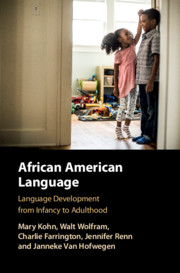Book contents
- African American Language
- African American Language
- Copyright page
- Contents
- Figures
- Tables
- Preface
- Abbreviations
- 1 Coming of Age in African American Language
- 2 The Analysis of Sociolinguistic Change over the Lifespan
- 3 Profiles of Change
- 4 Vowel Variation across Time and Space
- 5 Caretaker’s Influence on Vernacularity
- 6 The Influence of Peers on the Use of African American Language
- 7 Stylistic Variation in the Early AAL Lifespan
- 8 The Relationship of African American Language and Early Literacy Skills
- 9 A Longitudinal Study in Retrospect
- Appendix AAL Feature Code Key
- Index
- References
1 - Coming of Age in African American Language
Published online by Cambridge University Press: 24 November 2020
- African American Language
- African American Language
- Copyright page
- Contents
- Figures
- Tables
- Preface
- Abbreviations
- 1 Coming of Age in African American Language
- 2 The Analysis of Sociolinguistic Change over the Lifespan
- 3 Profiles of Change
- 4 Vowel Variation across Time and Space
- 5 Caretaker’s Influence on Vernacularity
- 6 The Influence of Peers on the Use of African American Language
- 7 Stylistic Variation in the Early AAL Lifespan
- 8 The Relationship of African American Language and Early Literacy Skills
- 9 A Longitudinal Study in Retrospect
- Appendix AAL Feature Code Key
- Index
- References
Summary
Most linguistic theories of language socialization from childhood to early adulthood are based on cross-sectional studies or case studies of individuals. The Frank Porter Graham (FPG) project radically breaks from this tradition by examining the longitudinal development of more than 70 African American children for the first 21 years of their lives. The result is an unprecedented, comprehensive study that offers insight into the trajectory of change from pre-school through post-secondary education for speakers of African American Language (AAL) and the primary factors that influence these changes during this vital stage in the lifespan.
Keywords
- Type
- Chapter
- Information
- African American LanguageLanguage development from Infancy to Adulthood, pp. 1 - 21Publisher: Cambridge University PressPrint publication year: 2020



